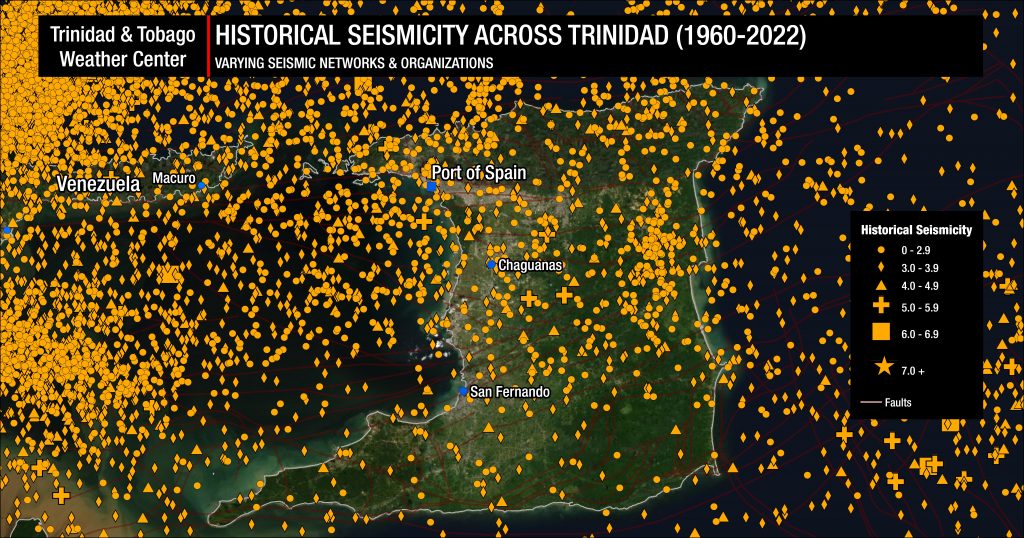At 8:52 PM Friday, February 16th, 2024, the University of the West Indies Seismic Research Center (UWI SRC) recorded a minor earthquake of magnitude 3.5 (mt) west of Grenada. The earthquake was not connected to the Kick’em Jenny submarine volcano, located northwest of the island, according to the UWI SRC.
The earthquake was preliminarily located at 61.83°W and 12.160°N, approximately 15 kilometers northwest of St. George’s, Grenada, 129 kilometers southwest of Kingstown, Saint Vincent and the Grenadines and 162 kilometers northwest of Scarborough, Trinidad and Tobago. The event was located at a depth of 10 kilometers.

This information is preliminary from the UWI SRC, the authority for seismic and volcanological information in the English-speaking Eastern Caribbean. Quake parameters may change upon further review by an analyst at the UWI SRC.
Brief, weak shaking has been reported across various areas of Grenada, with a quick, short jolt lasting no more than a few seconds. You can submit felt reports to the University of the West Indies Seismic Research Centre.
There is no tsunami threat.
There are four conditions necessary for an earthquake to cause a tsunami:
- The earthquake must occur beneath the ocean or cause material to slide within or into the ocean.
- The earthquake must be strong, with at least a magnitude of 6.5.
- The earthquake must rupture the Earth’s surface, and it must occur at a shallow depth – less than 70 kilometers below the surface of the Earth.
- The earthquake must cause vertical movement of the seafloor (up to several meters).
None of these conditions occurred.
Earthquakes & Kick’em Jenny
The UWI SRC has confirmed that this quake was a tectonic quake and not connected to the recent (now ceased) unrest at the Kick’em Jenny submarine volcano, located northwest of Grenada.
According to the University of the West Indies Seismic Research Center (UWI SRC), activity began to ramp up at 11:14 PM Friday, February 9th, 2024, and continued through 3:00 AM Sunday, February 11th, 2024. During this time, 3,400 earthquakes were recorded, with the largest measuring magnitude 3.3 on February 10th, and was reported felt across northern areas of Grenada.
However, according to the UWI SRC, activity has subsided both in magnitude and frequency and has returned to typical background levels.
The Kick’em Jenny volcano alert level has remained at Yellow, meaning seismicity and/or fumarolic activity are above the historical level, or other unusual activity has been observed or can be expected without warning. This is level two of four. An exclusion zone of 1.5 kilometers from the summit of the volcano is in effect for non-essential shipping. Kick’em Jenny’s alert level has been unchanged since March 22nd, 2018.
Has there been an increase in seismic activity?

Within 20 kilometers of Friday night’s earthquake, there have been nearly 30 recorded events recorded in the last 70 years. The largest recorded event within 20 kilometers of Friday’s quake occurred on October 24th, 2022, registering a magnitude of 4.2 on the Richter Scale. Seismic events in this area generally occur at depths between 0 and 20 kilometers below the surface, with another cluster of quakes occurring between 70 and 150 kilometers. In this area, at deeper levels, the South American plate is subducting under the Caribbean plate at a depth of 80 to 100 kilometers below the surface.
Trinidad and Tobago and the surrounding region are very seismically active. Across the Eastern Caribbean, over 2,200 earthquakes are recorded annually. Since 1990, the University of the West Indies Seismic Research Centre has recorded an annual average of 280 earthquakes in the Trinidad and Tobago region (area bounded by 9.5°- 11.5°N & 59.5°W – 63.5°W). Of these 280 quakes, 50 of these seismic events are, on average, above magnitude 3.5.
Most earthquakes occur northwest of Trinidad in an area known as North of the Paria Peninsula, which has the second-highest seismicity in the Eastern Caribbean. According to the UWI SRC, approximately 65 events of magnitude 2.1 and above are located in the area annually.
However, the UWI SRC has said regional seismic and volcanic activity has been elevated for several years in its annual report for 2020 to 2021.
On average, the Eastern Caribbean has seen a pattern of major (M7.0-M7.9) quakes every 20 to 30 years. That pattern has stayed true. The last major (M7.0-7.9) quake occurred north of Martinique in 2007.
Historical patterns indicate that great quakes (M8.0+) on the Richter Scale have occurred every century in the region. The probability of another event at that level is high since the last >M8.0 earthquake occurred in 1843. While it is impossible to say definitively when the next great quake will occur in the region, the time since the last one is now more than 170 years ago.
It is important to note seismic activity *cannot* be predicted – meaning the precise time, date, magnitude, depth, etc., cannot be known ahead of time based on current research and technology.
Now is the time to create or go over your earthquake preparedness plan and know what to do during, before, and after an earthquake.











